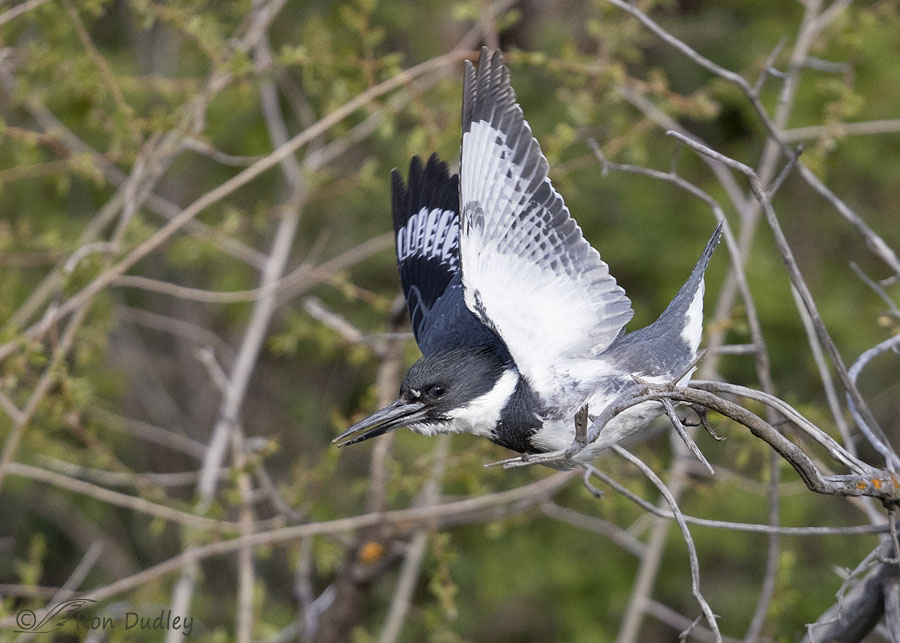My first decent kingfisher takeoff or flight shot in seven months.

1/2000, f/5.6, ISO 1600, Canon R5, Canon EF500mm f/4L IS II USM + 1.4 tc, not baited, set up or called in
If memory serves I haven’t had a good opportunity with a Belted Kingfisher since last October so six days ago in the mountains I was pretty happy to see (and hear) this guy fly in and land reasonably close to me. He fished the stream below him for quite a while without success so I got oodles of photos of him while he was perched but the setting was cluttered with branches and twigs so I’m not fond of those shots.
He didn’t dive on a fish a single time while he was here so my best chance for takeoff and flight shots would be if his patience ran out before mine did and he took off to fish elsewhere. It was a very long wait with my eye glued to the viewfinder but when he finally took off I got this single sharp shot that I like, despite its shortcomings.
Those shortcomings include a cluttered setting and whites under his wing that don’t have a lot of detail in them. I also wish I hadn’t had to crank up my ISO to 1600 in order to (barely) have enough shutter speed for flight shots. But I like his takoff posture (especially his wing position), I have light in his eye and most importantly, he’s sharp – even in such low light with a marginal shutter speed.
I have better kingfisher photos than this one but when I think back on all the years that kingfisher takeoff and flight shots were a huge nemesis for me it reminds me that back then I’d have given my shutter finger for a photo like this one. I suppose that’s hyperbole, but not by much.
It’s all a matter of perspective.
Ron


Flycatchers and kingfishers are almost always a delight esp for those of us who aren’t able to see them in the wild. And entertainment in your backyard is always a plus. With pollen counts high right now I am having to retreat to my “clean room” more frequently and at times like this blogs like yours are more welcome than ever. For entertainment at home I was therefore delighted to see that a Mallard pair has moved in to my urban back yard to join the feral Ring Neck pheasant and his harem of two who were already resident there.
So much to like about this shot. You introduced me to Belted Kingfishers (for that, I am very grateful!) and I’m always thrilled to see any shot of one gracing your blog.
Thanks, Marty.
Methinks your nemesis was vanquished long ago. The memory of the battle persists, perhaps to maintain a standard that we have come accustomed to, that few of us will ever attain, and that you so graciously share.
Yeah, it was a while ago Lyle. But the memory is still strong.
How things change. I am glad that this nemesis is largely done and dusted. And very glad to see this beauty. Even if his snowy whites make things difficult for you.
EC, in this low light I was a little surprised his whites were so bright, in part because my overall exposure was pretty good. That’s bird photography for you.
Those whites would make a fine laundry powder ad… And I hope to never see it.
Patience is a virtue 🙂 I happen to like his white wing underside – he’s got loads of color variations which is so appealing.
Kathleen, I must use up my limited supply of patience on birds because I sure don’t have much of it left over for other aspects of my life.
Sspectacular shot Ron! Thanks for sharing.
Charlotte Norton
Thanks, Charlotte.
These guys are pretty quick and hard to read. All things considered, it’s a pretty darn good shot.
“Pretty quick” indeed. Thanks, Michael.
Love this shot with the white underside of the left wing. Beautiful. Got the catch eye too and that is not always easy in the dark background of their face. I think you are having much fun with that R5. The whites really stand out in this photo.
We only have Kingfishers here in the winter. When it gets to late spring they are gone.
“I think you are having much fun with that R5”
Everett. the R5 still a mixed bag of fun and frustration. But slowly the former is beginning to dominate.
Good one perceived short comings and all! 🙂 “Expectations”/”wants” DO change over time…. 😉
Magpies are having a helluva time at one nest at the moment. Grackles have taken over a trees next to the one the magpie nest is an and are taking exception to the magpies entering/exiting the nest…
Sounds like you’ll be “entertained” for a while, Judy.